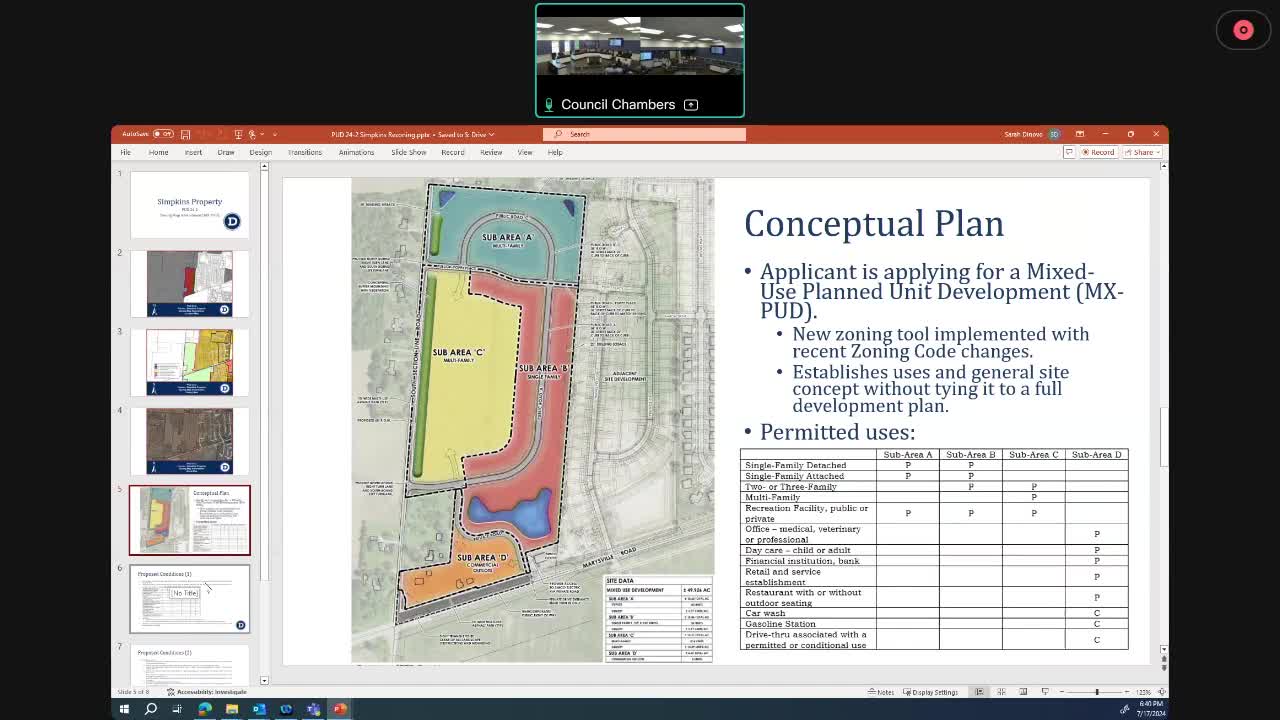New development plan sparks community zoning debate
July 17, 2024 | Delaware Planning Commission, Delaware City, Delaware County, Ohio

This article was created by AI summarizing key points discussed. AI makes mistakes, so for full details and context, please refer to the video of the full meeting. Please report any errors so we can fix them. Report an error »

In a recent government meeting, officials discussed a proposed development plan that includes a mix of residential and commercial uses across four subareas. The plan outlines various housing options, including single-family detached homes, townhomes, and potentially traditional multifamily units, with specific zoning conditions aimed at managing traffic and preserving existing landscapes.
Subarea A is designated for multifamily housing, although the proposal leans towards attached single-family units rather than traditional multifamily structures. Subarea B is expected to feature primarily single-family detached homes, while Subarea C may accommodate more traditional multifamily options. The southern portion of the site, Subarea D, is earmarked for commercial use, allowing for offices and restaurants, with conditional uses such as gas stations and drive-throughs requiring further board approval due to their potential impact on traffic.
The development plan includes several conditions to ensure proper oversight and management of the site. Access points to the development will be limited to those specified in the concept plan, with specific traffic management measures, including turn lanes and physical barriers to prevent illegal turns. A traffic impact study will also be required before any development applications can proceed.
Additionally, the plan emphasizes the importance of preserving existing trees and implementing landscape buffers to mitigate the impact of the new development on surrounding areas. Staff members recommended approval of the application, contingent on meeting nine outlined conditions.
The applicant, represented by attorney Michael Shade and planner Todd Ferris, expressed a willingness to address any concerns and highlighted ongoing discussions regarding necessary easements for utilities. They noted that negotiations with adjacent property owners are progressing, which could streamline future annexations and development plans.
Overall, the meeting underscored a collaborative approach to urban planning, allowing for community input while balancing the need for new housing and commercial opportunities in the area.
Subarea A is designated for multifamily housing, although the proposal leans towards attached single-family units rather than traditional multifamily structures. Subarea B is expected to feature primarily single-family detached homes, while Subarea C may accommodate more traditional multifamily options. The southern portion of the site, Subarea D, is earmarked for commercial use, allowing for offices and restaurants, with conditional uses such as gas stations and drive-throughs requiring further board approval due to their potential impact on traffic.
The development plan includes several conditions to ensure proper oversight and management of the site. Access points to the development will be limited to those specified in the concept plan, with specific traffic management measures, including turn lanes and physical barriers to prevent illegal turns. A traffic impact study will also be required before any development applications can proceed.
Additionally, the plan emphasizes the importance of preserving existing trees and implementing landscape buffers to mitigate the impact of the new development on surrounding areas. Staff members recommended approval of the application, contingent on meeting nine outlined conditions.
The applicant, represented by attorney Michael Shade and planner Todd Ferris, expressed a willingness to address any concerns and highlighted ongoing discussions regarding necessary easements for utilities. They noted that negotiations with adjacent property owners are progressing, which could streamline future annexations and development plans.
Overall, the meeting underscored a collaborative approach to urban planning, allowing for community input while balancing the need for new housing and commercial opportunities in the area.
View full meeting
This article is based on a recent meeting—watch the full video and explore the complete transcript for deeper insights into the discussion.
View full meeting
